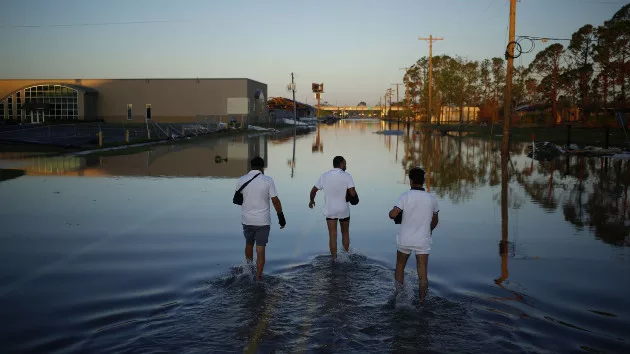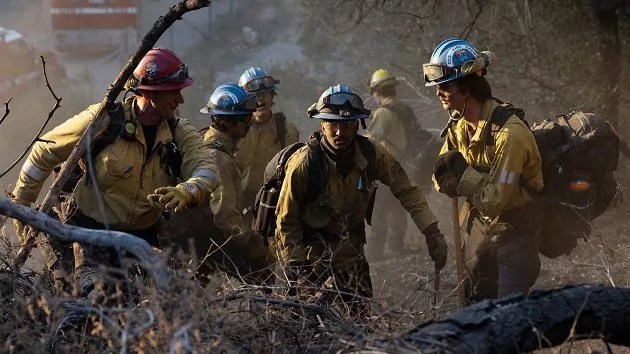
(NEW YORK) — When Harry and Jen Appel lost their home in Big Pine Key, Florida, to Hurricane Irma in 2017, they thought their insurance policies would cover the cost to repair and they’d rebuild in the same location.
The couple showed ABC News’ meteorologist Rob Marciano the spot where their home used to be, now an empty lot covered in sea lavender and some shards of their former life.
“If we would have got paid by insurance the right amount of money, it would have been a you would have been standing in a new house,” Harry Appel said. “Insurance was tough — that was worse than a storm.”
In September 2017, Hurricane Irma barrelled across the Atlantic with winds reaching 185 miles per hour — the strongest hurricane ever recorded in the Atlantic Ocean, according to the National Oceanic and Atmospheric Administration.
The Category 4 storm ravaged the Appel’s dream home, along with much of the region, leaving those hit hardest by the storm to contend with an insurance market already struggling to cover its claims.
Since moving into their home in Big Pine Key in 2015, the Appels paid into premium homeowner insurance policies — the National Flood Insurance Program provided by the Federal Emergency Management Agency.
“A week afterward, the guy came up from Texas — the underwriter for flood insurance for FEMA — and he came up and he looked at the house and for him to write a check on the spot for this entire policy, which was amazing. And at that point, I really felt better,” Harry Appel said.
Harry Appel told ABC News that FEMA paid out the $110,000 flood policy, but when the private insurance company responsible for the Appels’ wind coverage came to assess the damage, they claimed the damage had only been done by flooding, so the company wasn’t liable.
“We were entitled to this money,” Jen Appel said. “This was a contractual obligation that they did not live up to and it should have been paid.”
Home insurance isn’t mandatory by law, but banks often require homeowners to get insurance as a condition of a mortgage.
“The insurer’s goal is to collect more in premiums than they pay out in claims,” said Ben Keys, University of Pennsylvania Wharton School of Business professor of real estate and finance. “We’re seeing higher costs of materials, higher costs of labor, and those are growing faster than inflation.”
In recent decades, the intensity of some hurricanes has exploded, fueled by the warming seas, according to experts.
“We’re having more disasters, we’re having more costly disasters, and importantly, more people live in harm’s way,” Keys said. “So any individual disaster now leads to more payouts coming from the insurers — and they’re recognizing that these costs are rising quickly, not just because of inflation, and they’re reacting accordingly.”
2023 marked the most “billion dollar disasters” on record for the United States, with 25 climate-related disasters, according to NOAA.
As these events have gotten more costly, some of the largest private insurance companies, like Farmers, have left states like Florida entirely.
Still, other companies have gone insolvent due to the increasing cost of claims, leaving a market with fewer options for residents to choose from.
Three-fourths of Florida’s 21.5 million residents live in coastal counties, according to the Insurance Information Institute, and it was Hurricane Andrew in 1992 that first exposed the vulnerabilities of the private insurance market in the state.
In the aftermath of Andrew, Florida created a last-resort state-run program called Citizens Property Insurance Corporation with the mission of insuring homeowners who can’t otherwise find coverage.
“We’ve seen a number of large insurers go belly up, and in response, we’ve seen a lot of homeowners who are now dependent on the state’s public insurance plan. So Citizens Property Insurance is now the largest homeowner’s insurer in the state,” Keys said. “And what that points to is a private insurance market that’s simply not working.”
Florida is just one of 32 states and the District of Columbia that offers a state-run FAIR (Fair Access to Insurance Requirements) plan. Another of the 32, Louisiana, is struggling with some of the same issues.
Keys explained that sea level rise and more severe flooding after storms, “have continued to drive up costs for homeowners in that state.”
Tammy and Charles Guillory and their daughter Caylee lived inside the cramped quarters of an RV parked in their driveway for two years during the height of the COVID-19 pandemic after their home was hit by Hurricanes Laura and Delta in 2020.
“Some days I didn’t know how we was gonna make it, but we made it,” Tammy Guillory said. “It was hard.”
After the one-two punch of the hurricanes, just six weeks apart, the Guillorys turned to their insurance companies to pay out their policies.
“We did what we were supposed to do on our end of the bargain,” Tammy Guillory said. “Now it’s time for them to do what they are supposed to do.”
To have their policy paid, the Guillorys had to take their unmet claim to the courts.
They won their case, but the insurer appealed, so the family had to wait even longer.
“I was a client of this company for over 20 years with no missed payments — nothing,” Charles Guillory said. “But when it’s time for us to be able to receive, we have to go through this, and I don’t think it’s right.”
Attorney Michael Cox represented the Guillorys, along with hundreds of similar cases in the area.
“When you have this massive catastrophe, I think the insurance companies came in and they know statistically that most people will just walk away with the mistreatment — and they did,” Cox said. “Most people won’t fight like Charles and Tammy fought. They stood up for themselves and they were willing to go all the way to bat with this company.”
While the Guillorys eventually won their case, the story across the state doesn’t always have a happy ending.
Louisiana still has the third highest insurance premiums in the country, according to III. The market has been deteriorating since the state was hit by record hurricane activity in 2020, causing upwards of $23 billion in damage.
In the aftermath of the disasters, 12 insurers were declared insolvent because of their losses during that time and another 12 voluntarily withdrew from the state.
Over the last two years, Louisiana’s state-run insurance plan — Louisiana Citizens Property Insurance Corp. — more than tripled the number of policies it carries, from 35,000 to 128,000, according to the Louisiana Department of Insurance.
“The drama in Louisiana was that the state insurance regulator increased premiums by 65% earlier this year for the state-run plan,” Keys said. “And that was a recognition that they simply didn’t have enough capital on hand to weather an even moderate storm.”
The state government approved a $45 million fund in February of this year to help stabilize the market.
Insurance Commissioner Jim Donelon says it’s a first step to court companies to come back to the state.
“That’s a balance between the obligation we have to make insurance available, to attract companies and the obligation we have to make them responsive and fair with their policyholders,” Donelon said.
Reinsurance often creates another kink in the chain.
“Reinsurance is most easily thought of as insurance for insurance companies,” Keys explained. “So insurance companies are going to take on risky policies from homeowners all over the country, and they’re going to have a portfolio of risk, and they’d like to protect themselves from the worst case scenarios.”
As natural disasters become more costly around the country, the cost to stay for reinsurers is also increasing.
“They have a lot of influence in the decisions that insurers make,” Keys said. “They have invested heavily in climate modeling and they have some of the best data and the best models out there. And because this is the only business that they do, they have a lot of money at stake.”
As insurance issues continue across the Gulf Coast, some have looked to fortifying their homes to withstand these powerful storms as a possible solution.
At the University of Miami, researchers are testing how to fortify homes with their hurricane simulator, showing us that the way homes are built could be one key to reversing the insurance market retreat.
“Insurance companies, as well as reinsurance, rely heavily on numerical models,” UMiami assistant scientist Milan Curcic said. “How likely is it that certain areas will experience wind of this threshold, flooding of this level, and so on.”
While some can afford to fortify their homes and choose to self-insure, Keys said those who can’t should “shop around” for policies.
As for the Appels, they settled for a fraction of their policy payout after two years of litigation and being forced into escrow with their bank.
They now live in their bed and breakfast and have given up on rebuilding their home.
“When we don’t have a mortgage here, there will be no insurance here,” Jen Appel said. “So I’m joining the ranks with self-insuring, really self-insuring — don’t just say you’re going to self-insure. You better have a bankroll.”
While Harry is ready to move away, Jen says she doesn’t want to go.
“The only reason we’re still here is because I don’t want to go,” Jen Appel said. “But I didn’t go through all that to get to this point where I haven’t enjoyed any of it.”
Copyright © 2023, ABC Audio. All rights reserved.





